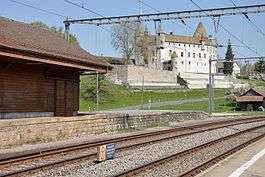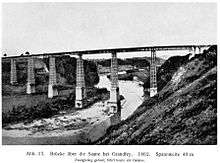Lausanne–Fribourg–Bern Railway
The Lausanne-Bern-Fribourg Railway (French: Chemin de Fer Lausanne-Bern-Fribourg, LFB) was a former railway company in Switzerland, which was formed in 1858 and absorbed into the Western Swiss Railway in 1872.
| Lausanne-Bern-Fribourg Railway | |
|---|---|
 | |
| Overview | |
| Native name | Chemin de fer Lausanne–Fribourg–Berne (LFB) |

The aim of the LFB was to connect the French-speaking part of western Switzerland with the German-speaking part of central Switzerland with a line from Lausanne to Bern via Oron and Fribourg. The line now forms part of the Lausanne–Bern railway, now owned by the Swiss Federal Railways.
History
Oron Railway Conflict
The aim of the LFB was to connect the western and French-speaking part of Switzerland with the central and German-speaking part of Switzerland with a line from Lausanne to Bern via Oron and Fribourg. The line now forms the Lausanne–Bern railway. However, it was preceded by a long history of dispute over the selection of the route between various canton interests between 1852 and 1857, known in German as the Oronbahnkonflikt (Oron railway conflict).
The cantons of Bern, Fribourg, Vaud and Geneva agreed on a rail link between Geneva and Bern in 1852. This line was to run from Bern to Geneva via Laupen, Murten, Payerne, Yverdon and Lausanne. Immediately thereafter, the West Switzerland Company (Compagnie de l'Ouest Suisse, OS) received the concession for its section through the Vaud.
The canton of Fribourg, however, wanted to benefit from the line and finally insisted that the line would have to run via Fribourg instead of via Laupen. The West Switzerland did not agree and insisted on the route via Murten and called on the Federal Assembly to issue a "compulsory" concession, overriding Fribourg.[note 1]
The Fribourg Grand Council decided on 27 November 1855 to build a railway line at public expense from Yverdon via Payerne-Freiburg to Thörishaus on the border with the canton of Bern at the request of Julien Schaller. The concession was to be issued to a start-up company called the Chemin de fer du canton de Fribourg ou du Centre Ouest Suisse (Canton of Fribourg or Central West Switzerland Railway). The Federal Assembly decided on 6 February 1856 in favour of Fribourg and the canton issued a concession to its company. Shortly later, Fribourg changed its plans and sought the construction of a direct route via Oron, which was about 26 km shorter, and issued a concession for it on 24 May 1856 to the Lyon-Geneva Railway (Chemin de fer Lyon-Genève).[note 2]

Lausanne, on the other hand, returned to the Federal Assembly and applied for a compulsory concession for the line via Murten. The Federal Council then consulted foreign experts, who recommended against the Oron line because of the considerable technical difficulties and higher development costs. Nevertheless, after violent debates on 23 September 1856, the Federal Assembly supported in principle the direct route via Oron.
Lausanne did not want to take part in negotiations proposed by the Federal Assembly, so the Confederation issued a compulsory concession for the construction of the line on Vaud soil to Fribourg. Vaud, on the other hand, sought a compulsory concession for the Murten line, but was rejected by the Federal Council on 31 July 1857. Vaud then objected to the federal decision and claimed the Federal Council had a conflict of competence. Finally, the unified Federal Assembly rejected the claim that it had a conflict of competence on 19 December 1857 and found that the national interest was greater for a line via Oron than a line via Murten.
Establishment of the company
The Oron Railway was able to acquire the concession for the Geneva–Versoix line from the Lyon-Geneva Railway (Chemin de fer Lyon-Genève) on 16 April 1858. It took over the Geneva–Versoix Railway (Chemin de fer Genève–Versoix, GV) on 1 July 1858—just six days after its opening. It was able to open the section from Thörishaus on the Bern–Fribourg canton border to Balliswil near Düdingen on 2 July 1860. A makeshift station was built near the northern abutment of the Grandfey Viaduct in the hamlet of Balliswil near Fribourg. The Bern–Törishaus section opened on the same day is located in the canton of Bern and belonged to the Swiss Central Railway (Schweizerische Centralbahn, SCB).
The LFB was able to open the remaining section from Lausanne to Balliswil on 4 September 1862 and thus accommodate through rail traffic between Bern and Lausanne. Financial difficulties, which arose during the construction of the Oron Railway, caused the LFB to transfer its line to the canton of Friborg on 12 November 1863. The canton of Vaud approved the transfer on 24 November 1866 and the canton of Geneva approved it on 9 May 1869.
The Lausanne-Bern-Fribourg Railway opened double-track between Versoix and Geneva in 1868. In the same year, the West Switzerland (Ouest Suisse) completed the second track from Gland to Versoix.
Association of the Railways of Western Switzerland

The connection from Geneva via Lausanne to German-speaking Switzerland was in the hands of three rail companies, which were often very competitive. Their ownership was largely based on cantonal borders. Like the LFB, the West Switzerland Company (Compagnie de l’Ouest Suisse; SO) and the Franco-Swiss Company (Franco-Suisse, FS) in the canton of Neuchâtel faced financial difficulties, which also stem from cost overruns in the construction work. The three railway companies formed a joint business called the Association des chemins de fer de la Suisse Occidentale (association of the railways of western Switzerland) on 1 January 1865 after lengthy negotiations. Their operations were contracted out to a company called Laurent-Bergeron et Comp. The financial situation of the three Western Swiss railway companies then stabilised and from 1868 onwards the companies were able to pay modest dividends each year.
On 1 January 1872, the Western Switzerland Railways (Suisse-Occidentale, SO) was established as a public limited company, in which the Oron Railway was fully integrated with the Western Switzerland and the Franco-Swiss. It became Switzerland's largest railway company, with a network that was 315 kilometres long.
Rolling stock
The following is a list of locomotives used on the LFB:
| Class | LFB no. | SO no. from 1865 | SO/SOS no. from 1871 | JS no. from 1890 | SBB no. from 1903 | Manufacturer | Build year | Scrapped |
|---|---|---|---|---|---|---|---|---|
| from 1873: II from 1887: B2 from 1902: Ec 2/4 | 1–12 | 1–12 | 51–62 | 251–262 | 6398, 6399 | Esslingen | 1862 | 1895–1905 |
References
Notes
- According to the Railway Act of 1852, the right to make concessions lay basically with the cantons. However, the Confederation had the right to issue compulsory concessions if it was in the interest of the whole country.
- The Geneva–Lyon Railway merged in 1857 with the Chemins de fer de Paris à Lyon et à la Méditerranée (PLM).
Footnotes
Sources
- Frey, Thomas; Schiedt, Hans-Ulrich. "Suisse Occidentale-Simplon". bahndaten.ch. Daten zu den Schweizer Eisenbahnen 1847–1920 (in German). ViaStoria. Retrieved 13 August 2019.CS1 maint: ref=harv (link)
- Moser, Alfred (1967). Der Dampfbetrieb der Schweizerischen Eisenbahnen 1847–1966 [The steam operation of the Swiss Railways 1847-1966] (in German). Basel and Stuttgart: Birkhäuser Verlag.CS1 maint: ref=harv (link)
- Wägli, Hans G. (1980). Schienennetz Schweiz (Swiss rail network) (in German). Bern: Swiss Federal Railways.CS1 maint: ref=harv (link)
- Weissenbach, Plazid (1913). Das Eisenbahnwesen der Schweiz [The Rail Industry of Switzerland] (PDF 14.8 MB) (in German). p. 66. Retrieved 13 August 2019.CS1 maint: ref=harv (link)
- Ein Jahrhundert Schweizer Bahnen (A century of Swiss railways) 1847–1947 (in German). I. Frauenfeld: Verlag Huber & Co. AG. 1947. pp. 80–82.